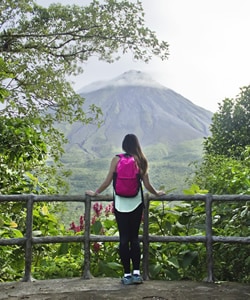Planning a trip to Costa Rica can be exciting and overwhelming, but with the right information, you can make the most of your adventure. Costa Rica offers travelers diverse experiences, from lush rainforests to pristine beaches. This Central American gem has something for everyone.
We’ll delve into the essential things to know before visiting Costa Rica, from understanding entry requirements and currency considerations to embracing eco-friendly practices and respecting local customs.
Whether you’re a first-time visitor or a seasoned traveler, these insights will help you navigate the intricacies of planning a trip to Costa Rica with confidence and ease.
So, join us as we embark on a journey of discovery, where we’ll uncover the essential insights and tips that will enhance your travel experience in Costa Rica.
With each insight and tip, you’ll be one step closer to immersing yourself in this enchanting destination’s beauty, wonder, and magic. Welcome to Costa Rica Tours—where every moment promises to be filled with excitement, discovery, and the pure joy of travel.
FREE! Travel eBook to discover Costa Rica!
Grab the eBook with the exhaustive brochure for your Costa Rica Vacation All-Inclusive.
*By clicking send, you agree to receive information about products, services, promotions, or recommendations via email.
Planning Your Trip to Costa Rica
Lo que vas a ver en este artículo
- 1 Planning Your Trip to Costa Rica
- 2 Things to Know Before Visiting Costa Rica
- 2.1 1. Navigating Entry Requirements
- 2.2 2. Mastering Currency and Payments
- 2.3 3. Prioritizing Health and Safety
- 2.4 4. Weather Forecasts and Packing Essentials
- 2.5 5. Unlocking Language and Communication
- 2.6 6. Navigating Transportation Options: Getting Around Costa Rica with Ease
- 2.7 7. Embracing Respect for Nature and Culture: Responsible Travel
- 3 Embarking on Your Costa Rican Adventure
Planning a trip to Costa Rica can be an exhilarating experience filled with anticipation for the lush landscapes, diverse wildlife, and vibrant culture awaiting you. Engaging in thorough planning is essential to ensure a smooth and memorable journey. Here are some invaluable tips to help you make the most of your trip to Costa Rica.
First and foremost, research is key. Take the time to familiarize yourself with Costa Rica’s geography, climate, and popular attractions. Understand the different regions, from the pristine beaches of Guanacaste to the lush rainforests of the Osa Peninsula.
Knowing what each area offers will allow you to tailor your itinerary to suit your interests and preferences. Additionally, researching local customs, language, and currency will help you navigate the country more effectively and respectfully.
When planning your trip to Costa Rica, consider the best time to visit. The country experiences two primary seasons: the dry season (December to April) and the wet season (May to November).
While the dry season typically offers sunny days and clear skies, the wet season brings lush green landscapes and fewer crowds. Depending on your preferences for weather and activities, choose the season that aligns with your desired experience.
Remember that certain activities, such as surfing or wildlife viewing, may be more favorable during specific times of the year. Incorporating eco-friendly practices into your trip to Costa Rica is responsible and enhances your experience of this biodiverse paradise.
Opt for eco-conscious accommodations that prioritize sustainability and support local communities. Additionally, minimize your environmental footprint by practicing responsible tourism, such as reducing plastic usage, conserving water and energy, and respecting wildlife habitats.
Treading lightly on the land, you preserve Costa Rica’s natural wonders for future generations. When planning your itinerary, embrace the spirit of adventure and exploration that defines Costa Rica.
While iconic destinations like Manuel Antonio National Park and Arenal Volcano are must-visit highlights, don’t hesitate to venture off the beaten path and discover hidden gems.
Engage in immersive experiences such as zip-lining through the cloud forests, hiking to remote waterfalls, or embarking on a wildlife safari. Allow flexibility in your schedule to serendipitously encounter the unexpected and savor the spontaneous moments that make your trip to Costa Rica unforgettable.
Researching DestinationsCosta Rica offers many destinations, each with its unique charm. Whether you’re interested in exploring lush rainforests, relaxing on pristine beaches, or discovering vibrant cities, research the different regions to find the perfect fit for your interests and preferences.
Things to Know Before Visiting Costa Rica
Before embarking on your journey to Costa Rica, there are several important things to know to ensure a smooth and enjoyable experience in this Central American paradise.
Before embarking on your trip to Costa Rica, it’s crucial to understand the entry requirements to ensure a hassle-free journey to this captivating destination. Whether planning a Costa Rica vacation all-inclusive or embarking on a business trip, adhering to the entry requirements is essential for a smooth arrival and enjoyable stay.
First and foremost, ensure that your passport is valid for at least six months beyond your intended stay in Costa Rica. This requirement is standard for most international travel destinations and applies equally to your Costa Rica trip planning.
A valid passport facilitates entry into the country and ensures you can explore its stunning landscapes and vibrant culture without interruptions.
Additionally, travelers to Costa Rica must possess proof of onward or return travel. This requirement is in place to ensure that visitors have concrete plans for departing the country within the permitted duration of their stay.
Whether you have a return flight booked or a confirmed itinerary for exiting Costa Rica via land or sea, having proof of onward travel is essential for meeting the entry requirements and avoiding any complications upon arrival.
Furthermore, depending on your nationality, you may need to obtain a visa before traveling to Costa Rica. While citizens of many countries are granted visa-free entry for short stays, others may require a tourist visa or a visa waiver.
It’s crucial to check the specific visa requirements based on your country of citizenship well in advance of your trip to Costa Rica. Obtaining the necessary visa documentation ensures you can enter the country legally and enjoy exploring its diverse landscapes and cultural attractions.
If you want to know more information, visit the Embassy of Costa Rica official website.
2. Mastering Currency and Payments
When planning your trip to Costa Rica, it’s essential to understand the local currency and payment options to ensure smooth transactions and financial convenience during your travels.
Familiarizing yourself with the currency and payment practices will enable you to budget effectively and make informed decisions while exploring this beautiful Central American destination.
The official currency of Costa Rica is the Costa Rican colón (CRC). While the colón is the primary form of payment for goods and services within the country, US dollars are widely accepted in tourist areas, hotels, and larger establishments.
However, it’s advisable to carry local currency for smaller purchases and transactions, as using US dollars may result in less favorable exchange rates or inconvenience for both you and the vendor.
When exchanging currency in Costa Rica, it’s recommended to do so at banks or authorized currency exchange offices for the most competitive rates and transparent transactions.
Avoid exchanging money at hotels or unofficial street vendors, as they may offer less favorable rates or engage in fraudulent practices. Additionally, be mindful of handling fees or commissions associated with currency exchange, especially when converting larger sums of money.
In terms of payment methods, credit cards are widely accepted in Costa Rica, particularly in urban centers, tourist areas, and upscale establishments. Visa and Mastercard are the most commonly accepted credit cards, followed by American Express and Discover, although their usage may be more limited.
When using credit cards, be aware of any foreign transaction or currency conversion fees your card issuer may charge. Also, inform your bank of travel plans to prevent issues with card usage abroad.
While credit cards offer convenience and security, especially for larger purchases or hotel reservations, it’s still advisable to carry cash for smaller transactions and in more remote areas where card acceptance may be limited.
ATMs are readily available in urban centers and tourist areas, allowing you to withdraw colónes directly from your bank account using your debit or credit card. However, be cautious when using ATMs, especially in isolated or poorly lit areas, and always shield your PIN when entering it.
If you want more information about Costa Rica, we invite you to read the next article: Caravan Tour to Costa Rica: Exploring Paradise on Wheels.
3. Prioritizing Health and Safety
Ensuring your health and safety is paramount when planning a trip to Costa Rica, a country renowned for its stunning natural beauty and diverse ecosystems.
By taking proactive measures and adhering to essential precautions, you can minimize risks and enjoy a safe and memorable experience exploring this captivating destination.
Before embarking on your trip to Costa Rica, it’s advisable to consult with a healthcare professional or travel medicine specialist to discuss any recommended vaccinations or preventive measures.
While no specific vaccinations are required for entry into Costa Rica, certain routine vaccinations, such as measles, mumps, rubella (MMR), and hepatitis A and B, may be recommended based on your travel history and individual health status.
Additionally, consider purchasing comprehensive travel insurance that includes coverage for medical emergencies, evacuation, and repatriation. Travel insurance provides invaluable peace of mind and financial protection in the event of unforeseen circumstances, such as illness, injury, or trip interruption, during your time in Costa Rica.
Costa Rica is generally considered a safe destination for travelers, but it’s essential to exercise caution and remain vigilant, especially in crowded tourist areas and urban centers. Keep your belongings secure and avoid displaying valuables to reduce the risk of theft or pickpocketing. Be cautious when exploring unfamiliar surroundings, especially at night, and trust your instincts if a situation feels unsafe or uncomfortable.
Regarding health precautions, protect yourself from mosquito-borne illnesses such as dengue fever, Zika virus, and chikungunya. Use insect repellent containing DEET or picaridin, wear long-sleeved clothing and pants, and sleep under mosquito nets, especially in areas prone to mosquito activity.
Additionally, practice safe food and water hygiene by consuming bottled or purified water, avoiding street food vendors with questionable hygiene standards, and washing fruits and vegetables thoroughly before eating.
4. Weather Forecasts and Packing Essentials
Understanding the weather patterns and packing accordingly is essential for planning a trip to Costa Rica. With its diverse landscapes ranging from tropical beaches to cloud forests, the weather in Costa Rica can vary significantly depending on the region and time of year.
By packing appropriately for the climate and activities you have planned, you can ensure a comfortable and enjoyable travel experience in this enchanting destination.
When preparing for your trip to Costa Rica, it’s important to consider the country’s two primary seasons: dry and wet. The dry season typically extends from December to April and is characterized by sunny days, clear skies, and lower humidity levels.
This period is ideal for beach vacations, outdoor activities, and exploring Costa Rica’s national parks and wildlife reserves. However, it’s essential to pack sunscreen, lightweight clothing, sunglasses, and a hat to protect yourself from the intense tropical sun.
On the other hand, the wet season in Costa Rica typically occurs from May to November, bringing frequent afternoon showers, lush green landscapes, and higher humidity levels.
While the wet season may deter some travelers, it offers unique opportunities to experience Costa Rica’s natural beauty in full bloom, with fewer crowds and vibrant foliage. When packing for the wet season, include a lightweight rain jacket or poncho, quick-drying clothing, waterproof footwear, and insect repellent to stay comfortable and dry during outdoor adventures.
Regardless of the season, it’s advisable to pack layers for your trip to Costa Rica, as temperatures can vary significantly between day and night and at different elevations. Along with lightweight, breathable clothing for warmer temperatures, include long-sleeved shirts, pants, and a fleece jacket or sweater for cooler evenings or higher elevations.
Don’t forget to pack sturdy walking shoes or hiking boots, especially if you plan to explore Costa Rica’s rugged terrain or participate in outdoor activities such as hiking, zip-lining, or horseback riding.
5. Unlocking Language and Communication
Navigating language and communication in Costa Rica can greatly enhance your travel experience, allowing you to connect with locals and immerse yourself in the vibrant culture of this Central American country.
Spanish is the official language of Costa Rica, but English is widely spoken in tourist areas, hotels, and restaurants. However, understanding some basic language and communication tips can help you navigate more confidently during your trip to Costa Rica.
Learning a few essential Spanish phrases before your trip to Costa Rica can go a long way in facilitating communication and showing respect for the local culture. Simple greetings such as “hola” (hello), “gracias” (thank you), and “por favor” (please) can help you interact with locals in a friendly and polite manner.
Additionally, knowing basic phrases for ordering food, asking for directions, and making purchases can help you easily navigate everyday situations.
While English is commonly spoken in tourist areas, particularly in urban centers and popular beach destinations, don’t assume that everyone you encounter will be fluent. English proficiency may be limited in more remote or rural areas, so a basic understanding of Spanish can be invaluable for communicating with locals and navigating everyday interactions.
Consider bringing a pocket-sized Spanish phrasebook or downloading a translation app to assist you when language barriers arise.
Patience and a positive attitude are key when communicating with locals during your trip to Costa Rica. Even if your Spanish skills are limited, making an effort to communicate in the local language can be greatly appreciated and often leads to more meaningful interactions.
Don’t be afraid to use gestures, facial expressions, or simple drawings to convey your message if you encounter difficulty expressing yourself verbally.
Exploring the diverse landscapes and attractions of Costa Rica requires efficient and reliable transportation options. Whether traversing the country’s scenic highways, navigating bustling city streets, or venturing into remote wilderness areas, understanding the various transportation options available can enhance your travel experience and make your trip to Costa Rica more enjoyable.
One of the most popular transportation options for travelers visiting Costa Rica is renting a car. Renting a car provides flexibility and independence, allowing you to explore at your own pace and access remote destinations that may not be easily reached by public transportation.
Costa Rica’s road network is generally well-maintained, with major highways connecting the country’s main cities and tourist destinations. However, it’s essential to know local driving conditions, including narrow roads, mountainous terrain, and unpredictable weather.
Costa Rica offers a comprehensive public bus network that provides affordable and convenient transportation between cities and towns for travelers who prefer not to drive or navigate unfamiliar roads.
The bus system is operated by several companies, with routes covering the majority of the country. While bus travel may take longer than driving, it offers the opportunity to interact with locals and experience the scenic beauty of Costa Rica’s landscapes from the comfort of a bus seat.
Another popular transportation option for travelers exploring Costa Rica is booking shuttle services or private transfers. Shuttle services operate regular routes between popular tourist destinations, such as airports, hotels, and national parks, making it easy to get around without driving or navigating public transportation.
Private transfers offer added convenience and comfort, allowing you to travel in style with a dedicated driver and vehicle. For travelers seeking to explore Costa Rica’s remote wilderness areas or offshore islands, domestic flights offer a quick and convenient way to reach distant destinations.
Several domestic airlines operate flights between major cities and regional airports, with short flight times making it possible to cover long distances in a fraction of the time compared to ground transportation.
7. Embracing Respect for Nature and Culture: Responsible Travel
Respecting nature and culture is paramount when embarking on a trip to Costa Rica, a country renowned for its rich biodiversity and vibrant heritage.
As you explore the stunning landscapes and immerse yourself in the local culture, it’s essential to adopt responsible and respectful behaviors that help preserve the natural environment and honor the traditions of Costa Rica’s diverse communities.
One of the fundamental principles of responsible travel in Costa Rica is practicing environmental conservation and minimizing your impact on the delicate ecosystems that make this country so unique.
From lush rainforests and pristine beaches to towering volcanoes and crystal-clear rivers, Costa Rica’s natural wonders are its most valuable assets. When visiting national parks, wildlife reserves, and protected areas, stay on designated trails, avoid littering, and avoid disturbing wildlife.
Treading lightly on the land and adhering to park regulations can help preserve these habitats for future generations.
In addition to protecting the natural environment, respecting Costa Rica’s cultural heritage and traditions is essential. Costa Ricans, known as “Ticos” and “Ticas,” take great pride in their cultural identity and customs, deeply rooted in a blend of indigenous, European, African, and Caribbean influences.
Take the time to learn about Costa Rica’s history, traditions, and social norms, and approach interactions with locals with curiosity, humility, and an open mind.
By familiarizing yourself with these essential tips before visiting Costa Rica, you can ensure a rewarding and unforgettable travel experience in this captivating destination. Whether exploring pristine beaches, trekking through dense rainforests, or immersing yourself in vibrant local culture, Costa Rica promises endless opportunities for adventure and discovery.
Embarking on Your Costa Rican Adventure
Your journey to Costa Rica promises an unforgettable adventure filled with breathtaking landscapes, rich biodiversity, and vibrant culture. As you prepare to embark on this tropical getaway, it’s essential to remember the valuable insights and tips shared throughout this guide to ensure a smooth and rewarding travel experience.
From planning your itinerary and understanding entry requirements to respecting nature and culture, each aspect of your trip to Costa Rica is crucial in shaping your overall experience.
Your trip to Costa Rica will be filled with awe-inspiring moments, enriching experiences, and unforgettable memories that ignite your sense of adventure and deepen your appreciation for the wonders of our planet. Safe travels, and may the pura vida spirit of Costa Rica accompany you wherever your journey may lead.
If you want more information about Costa Rica, we invite you to read the next article: Zipline Tour in Costa Rica: An Adventure Amidst Nature.
























